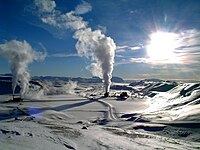
Photo from wikipedia
We investigate crustal deformation due to the extraction of water and steam from a high-enthalpy geothermal reservoir; a common occurrence, yet not well understood. The cause of this deformation can… Click to show full abstract
We investigate crustal deformation due to the extraction of water and steam from a high-enthalpy geothermal reservoir; a common occurrence, yet not well understood. The cause of this deformation can be a change in pressure or in temperature in the reservoir, both of which can be caused by extraction or injection of geothermal fluids. Our study area, the Hengill mountains in SW Iceland, is an active volcanic center and a plate triple junction that hosts two power plants producing geothermal energy. This combination of natural and anthropogenic processes causes a complex displacement field at the surface. We analyze geodetic data—Global Navigation Satellite System and Interferometric Synthetic Aperture Radar—to obtain the surface velocity field, which we then simulate using an inverse modeling approach. We focus on the deformation around the geothermal power plants but need to model the regional tectonic and volcanic deformation as well, because the signals are overlapping. We find that plate motion and a deep contracting body can explain the broad scale signal in the area. Local deformation near the two power plants, Hellisheidi and Nesjavellir, can be explained by extraction of geothermal fluids. We estimate reservoirs extending from 0.6 to 3.0 km depth at Hellisheidi, and 1.0 to 3.0 km depth at Nesjavellir for observed pressure decrease rates of 0.25 MPa/yr and 0.1 MPa/yr, respectively. We find that the main cause for the subsidence in the geothermal area is the observed pressure drawdown.
Journal Title: Journal of Geophysical Research
Year Published: 2017
Link to full text (if available)
Share on Social Media: Sign Up to like & get
recommendations!